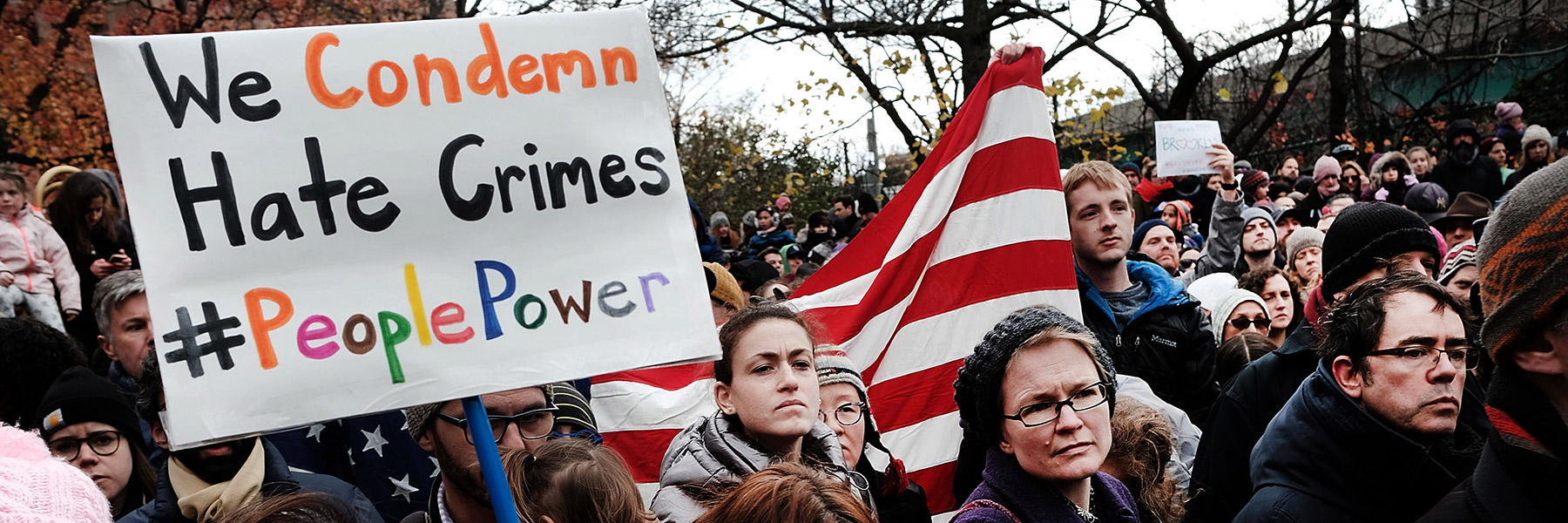
How To Fight Hate Crimes and White Nationalism in Trump's America
Standing against the far Right’s vision means we can't stay silent.
December 22, 2016
With the election of Donald Trump, the Right is triumphantly unveiling policy wish lists they’ve been compiling for decades. White supremacists and nationalists—many operating under the banner of the “alt-right”—see an opportunity to mainstream their anti-immigrant, anti-Muslim, anti-Semitic, racist vision of America.
Even before Trump takes office, we are seeing the implications of putting these ideas in the mainstream: In the first 10 days after the election, the Southern Poverty Law Center (SPLC) reported nearly 900 incidents of harassment and intimidation across the nation. According to the SPLC, “Many harassers invoked Trump’s name during assaults.”
In a Washington state public school, “build a wall” was chanted in the cafeteria at lunch. In Oakland, Calif., an Asian American leaving a train station was told to “go home.” According to the SPLC, “When an 18-year-old service employee in Kalamazoo, Mich., asked a man if he needed help, he replied, ‘I don’t need to ask you for shit. Donald Trump is president.’ He then called her a ‘black bitch’ and spat on her shoes.”
How can we help understand, cope with and combat this growing maelstrom of hate speech and attacks? A three-pronged approach is required: understanding and naming the alt-right, taking a public stand and organizing to take back political power.
Information is key. As Malcolm X said, “Reading and study are the activities that best reward effort.”
There are a million things to read, but potential starting points include Blood and Politics: The History of the White Nationalist Movement from the Margins to the Mainstream by Leonard Zeskind, president of the Institute for Research & Education on Human Rights (IREHR), and “How Trump Took Hate Groups Mainstream” by David Neiwert and Sarah Posner in Mother Jones. Only by understanding how they came to the spotlight can we strategize on how to push them back out.
We also need to shine “a clear spotlight on racists and extremist activity,” Neiwert wrote at his blog, making the public “better equipped when confronting [these issues’] inevitable manifestations in their real lives.”
We must call out the mainstream media when they excuse or soft-pedal the Right’s core of racism, misogyny, nativism, anti-Semitism and Islamophobia; and we must protest frequently and peacefully, joining the courageous people already standing against hate on the streets, in schools, in workplaces and online.
But in doing so, progressives must be careful not to label all Trump voters as bigots. Such labeling risks pushing them into the arms of a welcoming alt-right.
Instead, we should educate. Beyond simply marching and chanting, organizers can separate into groups and go out on the streets and door-to-door to talk to people about the rise of white nationalism and the need to stand against it.
“We need to reach the alt-right’s target demographic where they are, be that online or on college campuses,” Devin Burghart, vice president of IREHR, tells In These Times in an email. “We need to reach them before the alt-right does, and we need to build a culture of resistance … becoming allies, and creating bonds of solidarity across race, gender and class in confronting these bigoted ideas. Lastly, we need to have an alternative vision of the future to which young people can be drawn, not merely maintaining the status quo.”
This alternative vision must then go beyond protests and turn into an electoral strategy at both local and national levels, so this tide can be reversed. 
Bill Berkowitz is an Oakland, Calif.-based writer who has been monitoring and covering U.S. right-wing movements for the past 16 years.
How To Fight Hate Crimes and White Nationalism in Trump's America
by Bill Berkowitz
How Muslim Activists Are Organizing Against Islamophobia in the Face of President Trump
by Kalia Abiade
Resisting Trump’s Mass Deportation Agenda In the Streets and In the Courts
by Sameera Hafiz
Under Trump, Racial Justice Activists Must Seek Solutions Outside the State
by Asha Rosa Ransby-Sporn
The Only Way to Defeat Trump Is to Understand That Race and Class Are Inseparable
by Saqib Bhatti
Read the rest of this special series from the January 2017 issue of In These Times:
Want more stories on social movements and activism? Subscribe to the free In These Times weekly newsletter:
